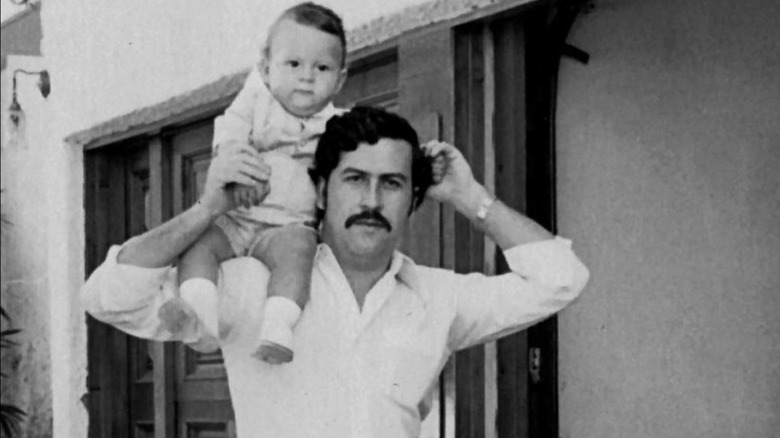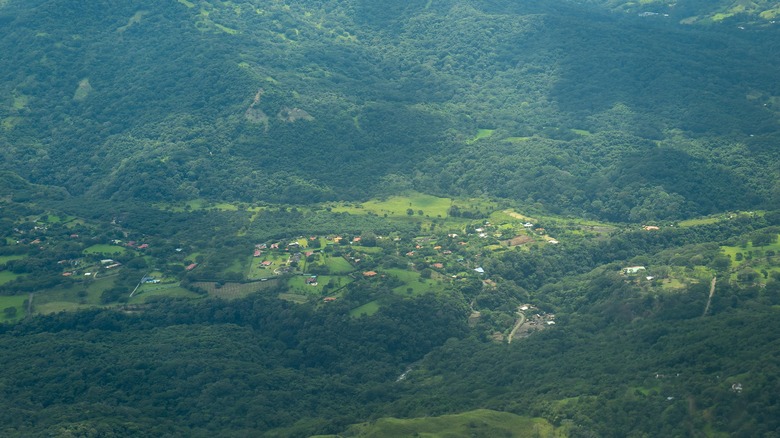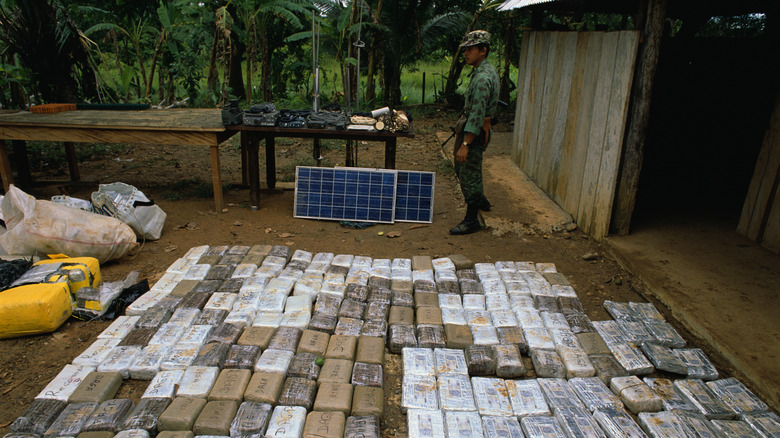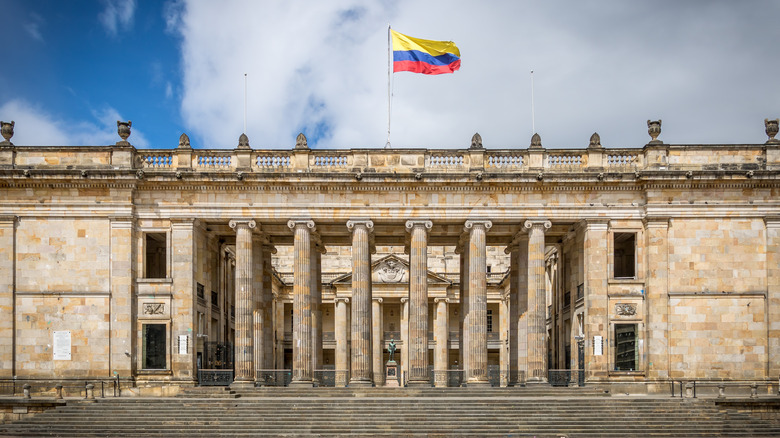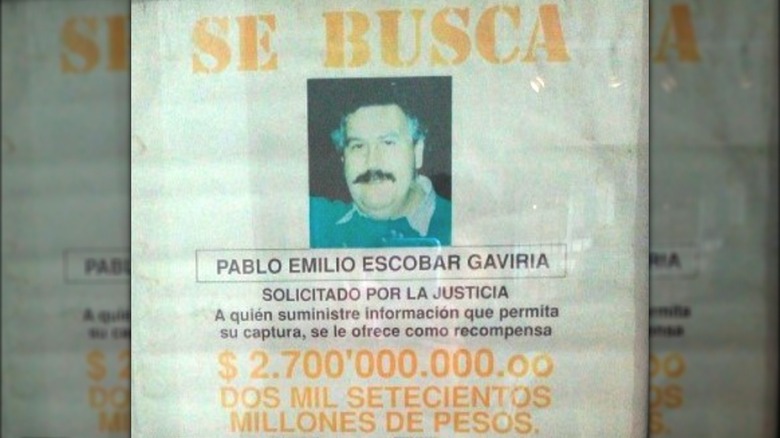Things 500 Days Of Escobar Didn't Tell You About Pablo
Contains spoilers for the Netflix documentary "500 Days of Escobar."
The feature-length documentary "500 Days of Escobar" made a big splash when it was first released in Colombia in 2023. Focused on the battle against the titular Pablo Escobar, the leader of the Medellin drug cartel and Columbia's most notorious drug trafficker, the documentary features interviews with some of the key figures in the Columbian drug wars, well as some of graphic footage of its brutal fallout.
As the documentary shows, for a period in the early 1990s, it seemed that Escobar was on course to face justice. The kingpin and a sizable group of his closest allies had been captured, and imprisoned in a luxury apartment nicknamed "la catedral." However, he escaped and went on the run for around 500 days, during which he terrorized Colombia with frequent and deadly acts of narco-terrorism. He was eventually discovered after investigators traced multiple phone calls he had made to his son, after which he was shot and killed in a raid by the Search Bloc wing of the Colombian National Police, though there were rumors that the vigilante Los Pepes group was also involved.
"500 Days of Escobar" has now landed on Netflix, meaning true crime aficionados the world over get the chance to witness the downfall and death of one of the mythic drug lord. But the documentary covers just what its title suggests: 500 Days. And clocking in with a runtime of under an hour and 20 minutes, a great many details in the story of Escobar are left out. Here are some eye-popping details that help fill out the Escobar story.
[Featured image by Ghazi777755 via Wikimedia Commons | Cropped and scaled | CC BY-SA 4.0]
The early life of Pablo Escobar
"500 Days of Escobar" chiefly covers the period in the early 1990s, from the cartel kingpin's time in custody having turned himself in to authorities in 1991, to his escape, time in hiding, and eventual violent death. As such, it leaves out a great deal of information concerning Escobar's early life, how he first became a criminal, and how he ended up being one of the richest outlaws in the world.
Escobar was born in Rionegro, Colombia (pictured), on December 1, 1949, to a farming father and a mother who worked as a school teacher. The family relocated to nearby suburban Medellin shortly after his birth. He was the third of seven children and later claimed to have been raised in poverty, though it has been reported that his family lived comfortably.
His life of crime began when he was in his early teens. He experimented with a wide range of schemes and petty thefts. According to Biography, one of his earliest crimes involved stealing and reselling tombstones, and forging and selling fake diplomas. As the years passed, he turned his attention to luxury goods, including stereos and cars, and was arrested in his mid-20s for vehicle theft. However, he continued to explore the world of organized crime, building his reputation during Colombia's so-called "Marlboro Wars," in which he became a cigarette smuggler and learned to effectively deploy violence against his enemies to achieve his aims.
The building of the Medellin cartel
As Pablo Escobar was learning the ropes of organized crime, cocaine continued to emerge as South America's most lucrative criminal asset. Before long, the career criminal came to understand that drug smuggling was to be a natural next step in terms of self-enrichment and attaining popular power in the region.
With Colombia well-positioned to process the coca crops of neighboring countries and export them to countries including the United States at great profit, in the mid-1970s Escobar and his allies formed the Medellin cartel, which within a decade became the most powerful cartel in the Western world. Their approach to both their rivals, the authorities, and informants helping to put an end to their drug smuggling activities proved to be uncommonly brutal. Escobar's use of heavy weaponry including dynamite, led to his being designated a "narco-terrorist." It is estimated that Escobar was responsible for the deaths of around 4,000 people during his lifetime.
Escobar's surprising political career
But Pablo Escobar didn't just exert influence over Colombia and the world drug trade as head of the brutally violent Medellin cartel. He also had his hands on the levels of power in his native country, having made his first steps into mainstream politics in 1982. By the late 1970s, the Medellin cartel was worth a fortune, with Escobar himself believed to have a personal wealth of around $30 billion. The kingpin spent his drug trafficking billions on a life of luxury, which included an enormous estate, the Hacienda Nápoles, which boasted gardens, a lake, a bullring, and Escobar's private menagerie which included a range of wild animals including hippos, elephants, and giraffes.
However, Escobar didn't simply keep his personal wealth to himself. Instead, he used his billions to fund several social programs that helped Colombians who were struggling in poverty, as Escobar alleged to have done in his early life. To the people of Medellin, Escobar became a beloved public figure, who exploited his popularity to be voted into Congress. He served as an alternate member for just two years before questions began to be asked about the source of his enormous wealth, and he was forced to resign. The Colombian Minister of Justice, Rodrigo Lara-Bonilla, was murdered shortly after, with Escobar suspected to be responsible for ordering the hit, one of several he made against prominent politicians and public figures.
Details about La Catedral
Pablo Escobar's surrender to the authorities in 1991 came at a time when it seemed the walls were closing in on him and his criminal empire. However, it proved to be a tactical retreat, and came with several provisos, the most unusual of which was that he was able to build his own prison.
As "500 Days of Escobar" makes clear, the resulting institution, La Catedral, which is located in the hills just outside of the city of Medellin, was no ordinary prison. As well as the soccer field, cozy living quarters, and huge TV sets featured in the documentary, La Catedral also had a luxury kitchen and hot tub, and guests reportedly included the Colombian national soccer team, who played against members of the cartel while Escobar's supposed prison guards served drinks. The kingpin's strangely palatial prison also catered to his family, with a huge dollhouse for his children to play with.
The end of Escobar's luxurious spell in his so-called "prison" came after it became clear to Colombian authorities that he had a hand in killing two cartel members at La Catedral who had complained about wages. With Escobar increasingly using his supposed prison as the continued headquarters of his drug trafficking empire — which continued to thrive — it was the final straw.
What was Escobar's life in hiding like?
"500 Days of Escobar" covers how the Medellin cartel kingpin saw his potential relocation from La Catedral to another more secure prison by the Colombian authorities to be a great danger to his power, which remained intact despite his technically being incarcerated. In response, he fled and went into hiding in July 1992. As the documentary shows, for a long time, the authorities would struggle to find any trace of Escobar, with search parties wasting much time exploring whether he remained hidden somewhere in La Catedral, or in the surrounding hills.
Instead, he was holed up in a house in the suburbs of Medellin. Escobar had, of course, grown used to a life of luxury, and luckily for him his hideout wasn't exactly a hovel, but instead a comfortable enough middle-class house, in the region of the city where he had been brought up. He remained in and around the house with his bodyguard Álvaro de Jesús Agudelo, but despite growing a beard that made him somewhat unrecognizable at first glance, he did little to hide himself from the outside world and continued to plan his narco-terrorist attacks against his enemies from his hideout until his was discovered via his telephone usage. The confrontation between Escobar and his pursuers was small-scale by the kingpin's own standards of violence and destruction, but nevertheless saw him shot to death on the roof of the house, a day after his 44th birthday.
[Featured image by Juandax via Wikimedia Commons | Cropped and scaled | CC BY-SA 4.0]
